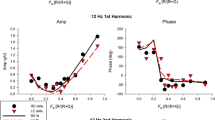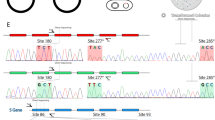Abstract
One hundred and six normal trichromatic males belonging to 51 families (48 two-sib families, 2 three-sib families and 1 four-sib family) and 100 normal trichromatic females from 46 families (40 two-sib, 4 three-sib and 2 four-sib families) between 18 and 28 years of age were tested for minor colour-vision defects (100-hue, Nagel and Pickford-Nicolson anomaloscopes).
A total of 112 abnormal features could be isolated statistically. If we consider that at least two abnormal features are necessary to establish the diagnosis of minor colour-vision defect, 23 affected persons were detected. Most of them presented with mixed deviant and weak defects.
No differences between males and females were detected in the number and type of defects, or in the distribution of defects, although 2 certain and 10 possible heterozygotes for the congenital red-green defects were not excluded from the female sample. One of the possible heterozygotes presented with a minor colour-vision defect.
No familial concentration of colour-weak or colour-deviant subjects could be detected.
Sib-sib correlations for the 100-hue and the anomaloscope results were investigated using two estimates based on analysis of variance: a method using a weighted mean family size (r A) and a maximum likelihood method based on successive approximations (r S). Heritability estimates, derived from r A for the 100-hue score, the midmatching points for the Nagel anomaloscope in Umstimmung and in Neutralstimmung, suggest a large contribution of additive genetic factors to the 100-hue score and the determination of the midmatching point in Neutralstimmung in males only. The possible reasons for the lower contribution of the additive genetic factors to the determination of these traits in females are unknown. The authors suggest more extensive family study to clarify the role of additive genes in the determination of the different traits.
Unique hues were determined by two means, with spectral lights of a von Helmholtz colorimeter and with the pigment colour of the 100-hue test.
All the frequency distributions of the unique hues were unimodal except for unique green in females, which was bimodal with both techniques. Frequency distributions of the unique hues in the 23 subjects with minor colour-vision defects were not significantly different from those of the 183 normal subjects.
Access this chapter
Tax calculation will be finalised at checkout
Purchases are for personal use only
Preview
Unable to display preview. Download preview PDF.
Similar content being viewed by others
References
Cobb, S. R. The luminosity curve for class I and class II colour normals Vision Res. 14: 529–533 (1974).
Donner, A. and Koval, J. J. The estimation of intraclass correlation in the analysis of family data. Biometrics 36: 19–25 (1980).
Falconer, D. S. Introduction to Quantitative Genetics. Oliver & Boyd ed., Edinburgh, London (1961).
Richards, W. Differences between color-normals: Classes I and II. J. Opt. Soc. Am. 57: 1047–1055 (1967).
Rubin, H. L. Spectral hue loci of normal and anomalous trichromats. Am. J. Ophthalmol, 52: 166–172(1961).
Smith, C. A. B. Estimation of genetic correlations. Ann. Hum. Genet. 43: 265–284 (1980).
Verriest, G., Vandevyvere, R. and Vanderdonck, R. Nouvelles recherches se rapportant à l’influence du sexe et de l’âge sur la discrimination chromatique, ainsi qu’à la signification pratique des résultats du test 100 hue de Farnsworth-Munsell. Rev. Opt. Théor. Instr. 41: 499–509(1962).
Verriest, G., Haurez, F. and Pièrart, P. Statistical demonstration of minor color vision abnormalities. Int. Ophthalmol. 5: 43–54 (1982).
Verriest, G., Van Laethem, J. and Uvijls, A. A new assessment of the normal ranges of the Farnsworth-Munsell 100 hue test-scores. Am. J. Ophthalmol. 93: 635–642 (1982).
Author information
Authors and Affiliations
Editor information
Editors and Affiliations
Rights and permissions
Copyright information
© 1989 Kluwer Academic Publishers, Dordrecht
About this chapter
Cite this chapter
De Bie, S., Wilmet, J., Verriest, G., Peirart, P. (1989). Minor Colour-Vision Defects: Sib-Sib Correlations and Relation to Unique Colours. In: Drum, B., Verriest, G. (eds) Colour Vision Deficiencies IX. Documenta Ophthalmologica Proceedings Series, vol 52. Springer, Dordrecht. https://doi.org/10.1007/978-94-009-2695-0_3
Download citation
DOI: https://doi.org/10.1007/978-94-009-2695-0_3
Publisher Name: Springer, Dordrecht
Print ISBN: 978-94-010-7715-6
Online ISBN: 978-94-009-2695-0
eBook Packages: Springer Book Archive




